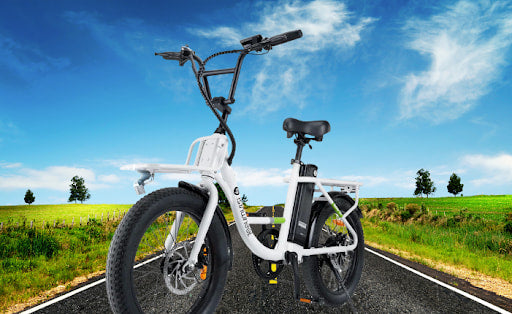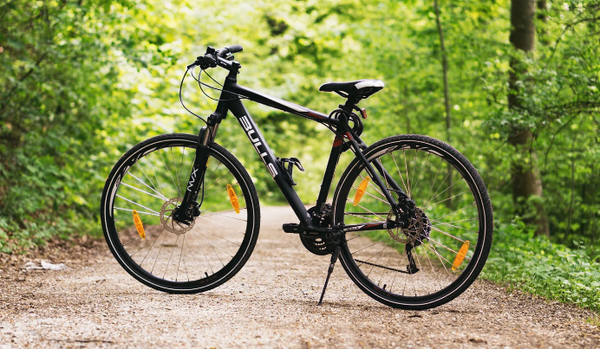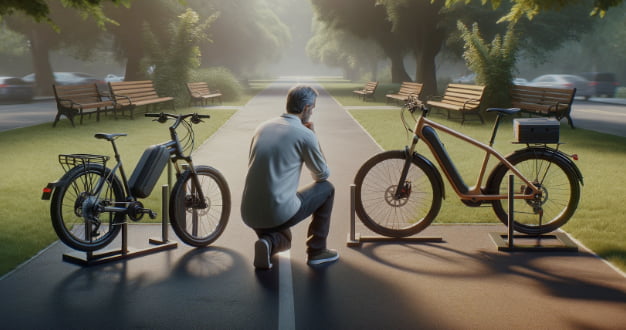
Electric bikes vs. regular bikes: which is better for you? Electric bikes have grown in popularity as they help riders go further and climb hills easier than traditional bikes.
Electric bikes come with a motor for pedal assistance, which means you can ride faster and farther with less effort. Regular bikes depend entirely on your pedaling power. If you want to travel long distances or conquer hills easily, an electric bike might be the better choice.
Cost is another factor to consider. Electric bikes typically cost more upfront because of their motor and battery, but they could save you money in the long run. They take less effort to ride, which could mean less spent on other forms of transport. Consider both the initial investment and potential savings when making your decision.
In this article, we will explore the differences between electric bikes vs. regular bikes, and provide you with the information you need to make an informed decision.
Find your ideal commuting partner within our diverse range of electric bikes for adults, designed to cater to the needs of every rider looking for efficiency, durability, and style.
What is an Electric Bike?

An electric bike, also known as an e-bike, is a bicycle that has an electric motor, a battery, and a controller. The electric motor is usually located in the hub of the rear wheel or in the bottom bracket of the bike, and it provides power to the pedals to help you ride.
The battery is usually mounted on the frame of the bike and provides power to the motor. The controller is the brain of the bike and controls the amount of power that is delivered to the motor.
Electric bikes come in different classes, which determine how fast and powerful they are. Class 1 e-bikes provide pedal assistance up to 20 mph, while Class 2 e-bikes can also be powered by a throttle and can go up to 20 mph. Class 3 e-bikes provide pedal assistance up to 28 mph.
Main Benefits of an Electric Bike
One of the main benefits of an electric bike is that it makes cycling easier and more accessible to a wider range of people. The motor assists when you need it, such as when you're going up a hill or against a headwind, which can make cycling less strenuous.
Electric bikes are also more environmentally friendly than cars and can be used for commuting, running errands, or just for fun. They can also save you money on gas and parking fees.
Check Out Our Top Electric Bikes
What is a Regular Bike?
A regular bike, also known as a traditional bike, is a human-powered vehicle that uses pedals to move forward. It consists of a frame, wheels, handlebars, pedals, and a chain that connects the pedals to the rear wheel. The rider sits on a saddle and uses their legs to pedal, which in turn rotates the wheels and propels the bike forward.

Unlike electric bikes, regular bikes do not have a motor or battery. As a result, they require physical effort from the rider to move forward. This means that the rider must be physically fit and able to pedal the bike for extended periods, especially if they plan to use the bike for commuting or long-distance rides.
Regular bikes come in various styles, including road bikes, mountain bikes, hybrid bikes, and cruiser bikes. Each style is designed for a specific purpose and has unique features that make it suitable for different types of terrain and riding conditions.
Some of the Key Features of a Regular Bike Include:
- Lightweight frame made of materials such as aluminum, carbon fiber, or steel
- Narrow tires that provide minimal rolling resistance and are suitable for smooth surfaces
- Drop or flat handlebars that allow the rider to adjust their position for comfort and efficiency
- Gears that enable the rider to adjust the resistance and speed of the bike based on the terrain and their fitness level
- Rim or disc brakes that provide stopping power when the rider applies pressure to the brake levers
Experience the joy of relaxed, comfortable rides with our stylish electric cruiser bikes, where classic design meets modern electric propulsion for the ultimate leisurely experience.
Electric Bike vs Regular Bike: Cost Comparison
When it comes to the cost of purchasing an electric bike versus a regular bike, there is no doubt that electric bikes are more expensive. Electric bikes have a higher initial cost due to their added features and components. On average, an electric bike can cost anywhere from $300 to $5,000, while a regular bike can be bought starting around $200 and can go up to $1,000 for high-end models.
Despite the higher initial cost of electric bikes, they can save you money in the long run. Electric bikes require less maintenance than regular bikes and don't need to be serviced as often. They also don't require gas or oil changes like a motorcycle or car, which can save you a lot of money over time.
Another cost to consider is the cost of charging an electric bike. It's important to note that the cost of charging an electric bike is significantly lower than the cost of fueling a car or motorcycle. You can charge an electric bike for just a few cents per charge, which is much cheaper than filling up a gas tank.
Replacing Parts Cost
When it comes to the cost of replacing parts, electric bikes can be more expensive than regular bikes. Electric bikes have more complex components, such as batteries and motors, that can be costly to replace if they break down. However, with proper maintenance and care, these components can last for years without needing to be replaced.
Maintenance Electric Bike vs Regular Bike
When it comes to maintenance, there are some key differences between electric bikes vs. regular bikes that you should be aware of. While both types of bikes require some basic maintenance, electric bikes can be more complex and expensive to maintain due to their electronic components.
Here are some maintenance considerations to keep in mind when comparing electric bikes and regular bikes:
1. Cleaning
Both electric bikes and regular bikes should be cleaned regularly to keep them in good condition. However, you should be extra careful when cleaning an electric bike because of its electronic components. Make sure to avoid spraying water directly onto the bike's electrical components and be gentle when cleaning around them.
2. Tires
Tire maintenance is important for both types of bikes. Regular bikes typically use standard tires that can be easily replaced and patched if necessary. Electric bikes, on the other hand, often use specialized tires that may be more expensive to replace.
3. Brakes
Brake maintenance is crucial for both types of bikes. Regular bikes typically use rim brakes or disc brakes that can be easily adjusted and replaced. Electric bikes may use hydraulic disc brakes, which can be more complex and expensive to maintain.
4. Battery
The battery is one of the most important components of an electric bike. To keep your electric bike's battery in good condition, you should follow the manufacturer's recommended maintenance schedule. This may include charging the battery regularly, avoiding extreme temperatures, and storing the bike properly when not in use.
5. Electronics
Electric bikes have more electronic components than regular bikes, which means they may require more specialized maintenance. If you're not comfortable working with electronics, it's best to take your electric bike to a professional for maintenance and repairs.
Usability and Convenience
When it comes to usability and convenience, electric bikes and regular bikes have their own unique advantages and disadvantages.
Let's take a closer look.
1. Urban Commuting
If you live in a city, an electric bike can be a great option for commuting. You can easily navigate through traffic and arrive at your destination without breaking a sweat. With an electric bike, you don't have to worry about finding parking or paying for gas. On the other hand, regular bikes can also be a good option for urban commuting, especially if you live in a bike-friendly city. You can easily weave in and out of traffic and get some exercise at the same time.
2. Long-Distance Travel
If you're planning a long-distance bike trip, a regular bike might be the better option. Regular bikes are generally lighter and more efficient than electric bikes, which means you can cover more ground with less effort. However, if you want to cover a lot of ground without putting in too much effort, an electric bike might be a good choice. With an electric bike, you can pedal as much or as little as you want, and the motor will help you out when you need it.
3. Recreational Use
If you're looking for a bike to use for recreation, both electric bikes and regular bikes can be good options. If you want to explore off-road trails or go mountain biking, a regular bike might be the better choice. However, if you want to take a leisurely ride through the park or along the beach, an electric bike can be a great way to enjoy the scenery without getting too tired.
Gain instant acceleration at your fingertips with our responsive electric bikes with throttle, perfect for those who appreciate a quick boost and effortless riding.
Fitness Benefits and Health Benefits: Electric Bike vs Regular Bike
When it comes to fitness and health benefits, both electric bikes and regular bikes have their advantages. However, the assistance level offered by e-bikes can make a significant difference in how much exercise you get while riding. Here's a breakdown of the fitness benefits of electric bikes compared to regular bikes:
1. Electric Bikes
- Low-impact exercise: E-bikes offer a low-impact workout, which is easier on your joints and muscles than high-impact activities like running or jumping. This makes e-bikes a great option for people with joint pain or injuries who still want to stay active.
- Assistance level: E-bikes have different assistance levels that can help you tailor your workout to your fitness level. You can choose to pedal with no assistance, low assistance, or high assistance, depending on how much of a challenge you want.
- Longer rides: With the help of an electric motor, you can ride for longer distances than on a regular bike. This means you can get more exercise and explore further without getting tired.
2. Regular Bikes
- Full-body workout: Riding a regular bike requires you to use your entire body, including your legs, arms, and core. This provides a full-body workout that can help you build strength and endurance.
- More challenging: Without the assistance of an electric motor, riding a regular bike requires more effort and can be more challenging. This can help you burn more calories and improve your fitness level.
- Versatile: Regular bikes can be ridden on a variety of terrains, from smooth roads to rough trails. This can provide a more varied workout and help you build different muscles.
Environmental Impact Electric Bike vs Regular Bike
When it comes to the environmental impact of electric bikes versus regular bikes, there are a few factors to consider.
Here's a comparison of the carbon footprint, energy consumption, and overall sustainability of both bike types:
1. Carbon Footprint
According to a study by the European Cyclists Federation, electric bikes create 2.5 to 5 grams of carbon dioxide per mile, compared to 150 grams per mile for an electric car. This makes electric bikes a much greener option than cars. However, regular bikes have an even smaller carbon footprint, producing no emissions at all.
2. Energy Consumption
Electric bikes require energy to charge their batteries, which can come from a variety of sources. If the electricity comes from renewable sources like solar or wind power, then the environmental impact is minimal. However, if the electricity comes from non-renewable sources like coal or natural gas, then the environmental impact can be significant. Regular bikes, on the other hand, require no energy to operate, making them the most energy-efficient option.
3. Overall Sustainability
When it comes to sustainability, electric bikes have some advantages over regular bikes. For example, they can be used by people who might not be able to ride a regular bike due to physical limitations. Additionally, electric bikes can be used for longer distances and uphill climbs, reducing the need for cars. However, electric bikes require batteries, which can be difficult to recycle and dispose of properly. Regular bikes, on the other hand, are simple machines that can last for decades with proper maintenance.
Pros and Cons Electric Bike vs Regular Bike
When it comes to choosing between an electric bike and a regular bike, there are pros and cons to consider for both.
Pros of Electric Bikes
- Assisted pedaling: Electric bikes provide a power-assisted pedaling experience, which can make it easier to ride uphill or for longer distances. This can be especially helpful for those with physical limitations or who are not used to cycling regularly.
- Higher speeds: Electric bikes can reach speeds of up to 20 miles per hour, which can make commuting faster and more efficient than using a regular bike.
- Reduced carbon emissions: Electric bikes are an eco-friendly transportation option that can reduce your carbon footprint.
Cons of Electric Bikes
- Higher cost: Electric bikes can be more expensive than regular bikes, with some models costing thousands of dollars.
- Heavier weight: Electric bikes are typically heavier than regular bikes, which can make them more difficult to transport or maneuver in tight spaces.
- Limited battery life: The battery life of an electric bike can be limited, which means you may need to recharge it more often than you would need to refuel a regular bike.
Pros of Regular Bikes
- Lower cost: Regular bikes are generally more affordable than electric bikes, making them a great option for those on a budget.
- Lightweight: Regular bikes are typically lighter than electric bikes, which can make them easier to transport and maneuver.
- No need for charging: Regular bikes don't require charging, which means you can ride them for as long as you want without worrying about running out of battery.
Cons of Regular Bikes
- Less assistance: Regular bikes require more physical effort to ride, which can be challenging for those with physical limitations or who are not used to cycling regularly.
- Slower speeds: Regular bikes can't reach the same speeds as electric bikes, which can make commuting longer and less efficient.
- Higher physical impact: Regular bikes can be harder on your body, especially if you're riding for long periods of time or over rough terrain.
Choosing Between an Electric Bike and a Regular Bike

When choosing between an electric bike and a regular bike, you must assess your needs and consider the value propositions of each option. Here are some key factors to consider:
1. Assessing Your Needs
The first step in choosing between an electric bike and a regular bike is to assess your specific needs. Do you plan on using your bike for commuting, leisurely rides, or fitness purposes? How far do you plan on riding, and what kind of terrain will you be covering? Answering these questions can help you determine which type of bike is best suited for your needs.
2. Value Propositions
Electric bikes offer several value propositions over regular bikes. For one, they're much easier to ride, especially if you're dealing with hills or other challenging terrain. They also allow you to cover longer distances with less effort. In addition, electric bikes are often more versatile than regular bikes, as they can be used for commuting, leisurely rides, or fitness purposes.
However, there are also some downsides to electric bikes. They tend to be more expensive than regular bikes, and they require charging. In addition, they're often heavier and bulkier than regular bikes, which can make them more difficult to transport or store.
Regular bikes, on the other hand, offer their own set of value propositions. They're typically less expensive than electric bikes, and they don't require charging. They're also lighter and more maneuverable than electric bikes, which can make them a better choice for certain types of riding.
Conclusion
In conclusion, electric bikes and regular bikes each have their own set of advantages and disadvantages. It ultimately depends on your personal preferences and needs.
If you are looking for a bike that can help you commute faster and more efficiently, an electric bike may be the right choice for you. They offer a motorized boost that can help you reach higher speeds with less effort. Additionally, electric bikes are great for those who want to tackle hilly terrain or long distances without getting too tired.
On the other hand, if you are looking for a bike that will give you a more traditional cycling experience, a regular bike may be the way to go. Regular bikes are lighter and more nimble than electric bikes, making them better suited for activities like racing or mountain biking. They also offer a more challenging workout, which can be great for those looking to improve their fitness.
It's important to consider all factors when deciding between an electric bike and a regular bike. If you are unsure which is right for you, consider test-riding both types of bikes before making a purchase. This will give you a better idea of which bike feels most comfortable and suits your needs.
Ready to explore on an eBike? Discover Isinwheel's premium selection of electric bikes, scooters, and skateboards at unbeatable prices. Contact us now for expert advice and start your adventure today!
Frequently Asked Questions
Are Electric Bikes Better Than Regular Bikes?
It depends on what you are looking for. Electric bikes are great for commuting, especially if you have a long way to go or if you need to carry a lot of things with you. They are also great for people who want to ride a bike but may have physical limitations. However, regular bikes are still a great choice for exercise and for people who enjoy the traditional biking experience.
What is the Difference Between a Normal Bike and an Electric Bike?
The main difference between a normal bike and an electric bike is that an electric bike has a motor and a battery. The motor helps to power the bike, making it easier to pedal and allowing you to go faster and further than you would on a normal bike. The battery provides the power for the motor, and can be charged using a regular power outlet.
Can You Ride Electric Bike Without Battery?
Yes, you can ride an electric bike without the battery, but it will be much more difficult to pedal than a regular bike. The motor is what makes it easier to pedal, so without it, you will need to rely on your own strength to get the bike moving.
Can You Still Get Fit on an Electric Bike?
Yes, you can still get fit on an electric bike. While the motor does make it easier to pedal, you can still get a great workout if you choose to pedal without the motor. You can also adjust the level of assistance provided by the motor, so you can still get a good workout while using the motor to help you when you need it.
Are Electric Bikes Easy to Pedal?
Yes, electric bikes are easy to pedal. The motor assists, making it easier to pedal, especially when going up hills or against the wind. You can also adjust the level of assistance provided by the motor, so you can choose how much help you want when you are pedaling.
How Fast is the E-Bike Compared to the Regular Bike?
The speed of an electric bike depends on the model and the level of assistance provided by the motor. Most electric bikes can reach speeds of up to 20 mph, while some can go even faster. Regular bikes, on the other hand, can go as fast as you can pedal them. However, it's important to note that electric bikes are heavier than regular bikes, so they may not be as nimble or easy to maneuver.












































